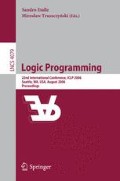Abstract
We describe an approach to modelling biological networks by action languages via answer set programming. To this end, we propose an action language for modelling biological networks, building on previous work by Baral et al. We introduce its syntax and semantics along with a translation into answer set programming. Finally, we describe one of its applications, namely, the sulfur starvation response-pathway of the model plant Arabidopsis thaliana and sketch the functionality of our system and its usage.
Access this chapter
Tax calculation will be finalised at checkout
Purchases are for personal use only
Preview
Unable to display preview. Download preview PDF.
References
Reddy, V., Mavrovouniotis, M., Liebman, M.: Petri net representations in metabolic pathways. In: Proc. First ISMB, pp. 328–336 (1993)
Pinney, J.W., Westhead, D.R., McConkey, G.A.: Petri net representations in systems biology. Biochem. Soc. Trans. 31(pt 6), 1513–1515 (2003)
Bonarius, H.P.J., Schmid, G., Tramper, J.: Flux analysis of underdetermined metabolic networks: The quest for the missing constraints. Trends Biotechnol. 15, 308–314 (1997)
Shmulevich, I., Dougherty, E., Kim, S., Zhang, W.: Probabilistic boolean networks: A rule-based uncertainty model for gene regulatory networks. Bioinformatics 18(2), 261–274 (2002)
Baral, C., Chancellor, K., Tran, N., Tran, N., Joy, A., Berens, M.: A knowledge based approach for representing and reasoning about signaling networks. In: ISMB, pp. 15–22 (2004)
Tran, N., Baral, C.: Reasoning about triggered actions in ansprolog and its application to molecular interactions in cells. In: KR 2004, pp. 554–564 (2004)
Gelfond, M., Lifschitz, V.: Representing action and change by logic programs. Journal of Logic Programming 17, 301–321 (1993)
Gelfond, M., Lifschitz, V.: Action languages. Electron. Trans. Artif. Intell. 2, 193–210 (1998)
Giunchiglia, E., Lifschitz, V.: An action language based on causal explanation: preliminary report. In: AAAI/IAAI, pp. 623–630. AAAI Press, Menlo Park (1998)
Eiter, T., Faber, W., Leone, N., Pfeifer, G., Polleres, A.: Planning under Incomplete Knowledge. In: Palamidessi, C., Moniz Pereira, L., Lloyd, J.W., Dahl, V., Furbach, U., Kerber, M., Lau, K.-K., Sagiv, Y., Stuckey, P.J. (eds.) CL 2000. LNCS (LNAI), vol. 1861, pp. 807–821. Springer, Heidelberg (2000)
Tran, N., Baral, C., Shankland, C.: Issues in reasoning about interaction networks in cells: Necessity of event ordering knowledge. In: AAAI, pp. 676–681. AAAI Press, Menlo Park (2005)
Grell, S.: Investigation and analysis of new approaches for representing and reasoning about biological networks using action languages. Diploma thesis, University of Potsdam and Max Planck Institute of Molecular Plant Physiology (2006)
Baral, C.: Knowledge Representation, Reasoning and Declarative Problem Solving. Cambridge University Press, Cambridge (2003)
Gelfond, M., Lifschitz, V.: Classical negation in logic programs and disjunctive databases. New Generation Computing 9, 365–385 (1991)
Simons, P., Niemelä, I., Soininen, T.: Extending and implementing the stable model semantics. Artificial Intelligence 138(1-2), 181–234 (2002)
Papatheodorou, I., Kakas, A.C., Sergot, M.J.: Inference of Gene Relations from Microarray Data by Abduction. In: Baral, C., Greco, G., Leone, N., Terracina, G. (eds.) LPNMR 2005. LNCS (LNAI), vol. 3662, pp. 389–393. Springer, Heidelberg (2005)
Chabrier-Rivier, N., Fages, F., Soliman, S.: The Biochemical Abstract Machine BIOCHAM. In: Danos, V., Schachter, V. (eds.) CMSB 2004. LNCS (LNBI), vol. 3082, pp. 172–191. Springer, Heidelberg (2005)
Clarke, E., Grumberg, O., Peled, D.: Model checking. MIT Press, Cambridge (1999)
Author information
Authors and Affiliations
Editor information
Editors and Affiliations
Rights and permissions
Copyright information
© 2006 Springer-Verlag Berlin Heidelberg
About this paper
Cite this paper
Grell, S., Schaub, T., Selbig, J. (2006). Modelling Biological Networks by Action Languages Via Answer Set Programming. In: Etalle, S., Truszczyński, M. (eds) Logic Programming. ICLP 2006. Lecture Notes in Computer Science, vol 4079. Springer, Berlin, Heidelberg. https://doi.org/10.1007/11799573_22
Download citation
DOI: https://doi.org/10.1007/11799573_22
Publisher Name: Springer, Berlin, Heidelberg
Print ISBN: 978-3-540-36635-5
Online ISBN: 978-3-540-36636-2
eBook Packages: Computer ScienceComputer Science (R0)

